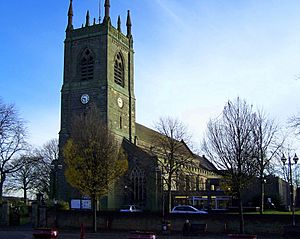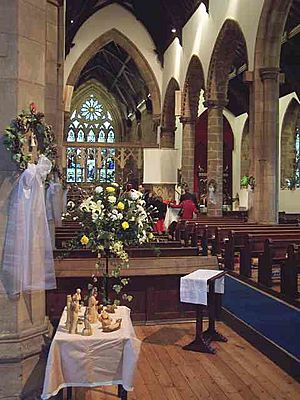St Mary's Church, Ilkeston facts for kids
Quick facts for kids St Mary’s Church, Ilkeston |
|
|---|---|

St Mary’s Church, Ilkeston
|
|
| 52°58′14.61″N 1°18′32.95″W / 52.9707250°N 1.3091528°W | |
| Location | Ilkeston |
| Country | England |
| Denomination | Church of England |
| Website | stmarysilkeston.co.uk |
| History | |
| Dedication | St Mary |
| Architecture | |
| Heritage designation | Grade II* listed |
| Administration | |
| Parish | Ilkeston |
| Deanery | Erewash |
| Archdeaconry | Derby |
| Diocese | Diocese of Derby |
St Mary's Church, Ilkeston is a very old and important parish church in Ilkeston, Derbyshire, England. It belongs to the Church of England. This church is so special that it is listed as a Grade II* listed building, meaning it's a particularly important building of more than special interest. It was built in the 14th century. Some people call it the "Mollis Chapel" because of a beautiful stained glass window inside. This window shows the sun rising above a cross.
Contents
History of St Mary's Church
The church was first started around the year 1150. The oldest parts you can still see today are three Norman arches in the south side of the church. These arches were built in the late 1100s. At that time, the Norman style of building was changing into an early English style. An expert report from 1855 said that these arches are very special and beautiful.
Another amazing part of the church is the area between the main altar (chancel) and the Peter Chapel. It has early English arches with carvings of small leaves. If you look closely, you might even see some playful "green men" faces hidden in the leaves!
Between the chancel and the Peter Chapel, there is a stone tomb with a statue of Sir Nicholas de Cantilupe. He was an important person who lived a long time ago and passed away in 1266. His tomb would have been in the middle of the church in the past.
The Church and Dale Abbey
In the late Middle Ages, the control of St Mary's Church was given to Dale Abbey. This was a nearby monastery. Giving churches to monasteries was a big deal back then. It had financial and political effects for the king. So, people sometimes found clever ways to make these gifts happen.
In 1385, King Richard II allowed a group of people to give the church's patronage (the right to choose the vicar) to Dale Abbey. These people were acting for William la Zouche, 3rd Baron Zouche. His family had inherited the church from the Cantilupe family. William wanted to make sure he and his family would be remembered with prayers at Dale Abbey.
Challenges and Changes
The transfer of the church caused some problems. In 1394, Pope Boniface IX tried to appoint his own vicar, John de Aston, to St Mary's. This went against English law at the time, which said the Pope couldn't make such appointments. John de Aston was even put in prison for trying to take over the church! He was later released and tried again to seize the church with a group of people. The local bishop had to ask the king for help. The issue finally ended during the reign of Henry IV.
Later, the control of Ilkeston manor, which included the church, changed hands. King Henry VII gave it to John Savage (soldier) because he helped in the Battle of Bosworth. This was after the previous owner, the 7th Baron Zouche, lost it for supporting King Richard III.
St Mary's Church stayed with Dale Abbey until the Dissolution of the Monasteries. This was when King Henry VIII closed down all the monasteries in England. After that, the Savage family was able to buy the church. Later, in 1608, the church was sold to Sir John Manners.
Restorations and Repairs
In 1714, the tall spire on the church tower was hit by lightning and destroyed.
The church had a big restoration between 1853 and 1855. This work was led by Thomas Larkins Walker. The sides of the church (north and south aisles) were rebuilt. A special chapel was rebuilt to make space for almost 300 children. The arch leading to the chancel was repaired, and the tower was given a new outer layer of stone. A new room for the clergy (vestry) was added. New seats, flooring, heating, and lighting were also put in. The church reopened on October 18, 1855.
More work was done between 1909 and 1910 by Percy Heylyn Currey. The west end of the church was made bigger and rebuilt. The tower was carefully taken apart stone by stone and then put back together exactly as it looks today. The church was reopened for worship on September 20, 1910.
Church Organ
The church has an organ built by Bishop in 1831. It was originally in another church in London. It is said that a famous composer named Mendelssohn might have played this organ! You can find more details about the organ on the National Pipe Organ Register.
Organists
- Henry Hoggard Beaumont (1872-1919)
- Cecil Wyer (1919 - unknown)
Church Bells
St Mary's Church has eight bells. They were remade by John Taylor of Loughborough in 1910. The bells had a big restoration and were rehung in 2015, so they are ready to ring for many more years!
See also
- Grade II* listed buildings in Erewash
- Listed buildings in Ilkeston



